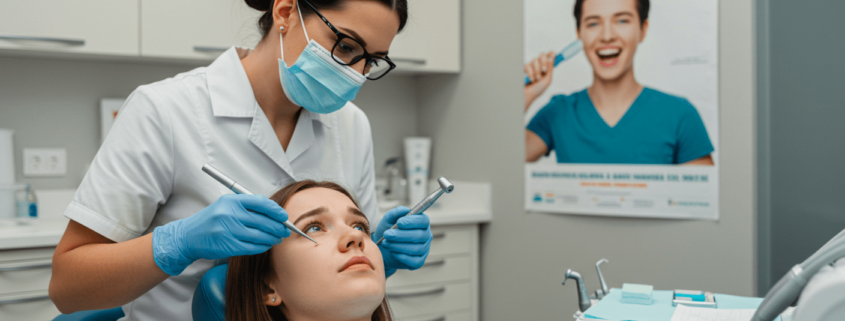The Psychology of Dental Fear: How to Overcome Anxiety at the Dentist
Does the thought of sitting in a dentist’s chair make your heart race? You’re not alone. Up to 36% of people experience dental anxiety, and nearly 12% have an extreme fear of the dentist (source). But avoiding dental care can lead to serious health issues, more pain, and even higher costs in the long run.
Understanding the psychology of dental fear can help you take control of your anxiety and turn dental visits into a stress-free experience. Whether your fear stems from past trauma, pain, loss of control, or the unknown, there are practical ways to manage and overcome it.
Let’s break down why dental fear exists and explore effective strategies to help you feel calm and confident at the dentist.
TL;DR – Quick Guide
- Dental fear is common and often linked to past trauma, pain, or a fear of losing control.
- Avoiding the dentist leads to worse problems (pain, infections, costly treatments).
- Techniques like deep breathing, sedation, and gradual exposure can help ease anxiety.
- Modern dentistry is more comfortable—pain-free treatments are available!
- Communicating with your dentist is key to feeling safe and in control.
What Causes Dental Fear?
1. Past Negative Experiences
A traumatic dental visit in childhood (or even as an adult) can create lasting anxiety. Painful procedures, rough dentists, or feeling unheard can make future visits stressful.
2. Fear of Pain
Let’s be honest—no one likes pain. Even though modern dentistry is far less painful than in the past, the fear of discomfort keeps many people from seeking care.
3. Loss of Control & Vulnerability
Lying back in a chair with your mouth open while someone works on your teeth can feel uncomfortable and powerless. This lack of control can heighten anxiety.
4. Sensory Overload
The sounds of drills, bright lights, and unfamiliar smells can trigger stress and discomfort for many patients. Those with sensory sensitivities may find it overwhelming.
5. Fear of Judgment
Many people avoid the dentist due to embarrassment about their teeth. Worrying about being judged for poor oral health can intensify anxiety.
How to Overcome Dental Anxiety
1. Choose the Right Dentist
Finding a compassionate, patient-friendly dentist makes all the difference. Look for:
- A dentist who specializes in treating anxious patients.
- Offices that offer calming environments (soft lighting, music, or aromatherapy).
- A dental team that takes time to explain procedures and listen to your concerns.
2. Communicate Your Fears
You’re not alone—dentists are trained to help anxious patients. Let them know about your fears so they can:
✅ Explain each step to reduce uncertainty.
✅ Use gentle techniques and go at your pace.
✅ Offer breaks during the appointment.
3. Try Relaxation Techniques
Before and during your visit, try:
🧘 Deep Breathing: Inhale for four seconds, hold for four, exhale for four. Repeat.
🎧 Distraction: Listen to calming music or a podcast during your appointment.
👐 Progressive Muscle Relaxation: Tense and relax different muscle groups to reduce stress.
4. Consider Sedation Options
For severe anxiety, sedation dentistry can help. Options include:
- Nitrous oxide (laughing gas) – Keeps you relaxed but fully conscious.
- Oral sedation (anti-anxiety medication) – Helps calm nerves before your visit.
- IV sedation or general anesthesia – For extreme fear or lengthy procedures.
5. Start Small & Build Confidence
If fear keeps you from the dentist, ease into it with small steps:
- Book a consultation—just talk to the dentist, no treatment needed.
- Schedule a basic cleaning before committing to major work.
- Bring a friend or family member for support.
Each positive experience helps retrain your brain to feel safe at the dentist.
The Role of Modern Dentistry in Reducing Anxiety
Dentistry has come a long way! Many pain-free and minimally invasive treatments are now available, including:
✔ Laser dentistry – Reduces the need for drills and numbing injections.
✔ Needle-free anesthesia – New methods like numbing gels and sprays make injections painless.
✔ Quieter, more comfortable tools – No more scary, loud drills!
✔ Faster treatments – Advanced technology makes procedures quicker and easier.
If it’s been years since your last visit, you might be surprised at how much has changed!
Key Takeaways
✔ Dental fear is common but manageable with the right strategies.
✔ Communication is key—let your dentist know your concerns.
✔ Relaxation techniques & sedation options can ease anxiety.
✔ Modern dentistry is far less painful than most people expect.
✔ Taking small steps builds confidence and makes future visits easier.
Facing your fears starts with one step—booking that appointment!
FAQs
1. How do I tell my dentist I have dental anxiety?
Be honest! Simply say, “I have dental anxiety”, and your dentist will adjust their approach to help you feel comfortable. Many dental offices specialize in treating anxious patients.
2. Can I be put to sleep for dental procedures?
Yes! IV sedation or general anesthesia is available for severe dental phobia or complex procedures. However, many patients find that oral sedation or nitrous oxide is enough to relax them.
3. What if I haven’t been to the dentist in years?
Don’t worry! Dentists are there to help, not judge. Many people avoid dental care due to fear, but starting now can prevent future problems. Find a dentist who specializes in gentle care.
4. How can I make my child less afraid of the dentist?
Start young! Read books about the dentist, play “pretend dentist” at home, and choose a kid-friendly dentist. Keeping a positive, upbeat attitude also helps kids feel safe.
5. Is dental anxiety genetic?
There’s evidence that fear of the dentist can be learned from parents or family members. However, positive experiences and gentle care can help overcome inherited anxiety.




Leave a Reply
Want to join the discussion?Feel free to contribute!